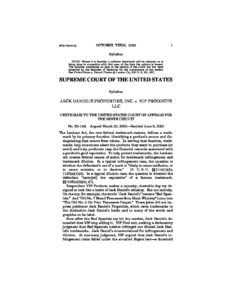By Katie Vetter
The U.S. Supreme Court announced its decision in Jack Daniel's Properties, Inc. v. VIP Products LLC on June 8, 2023. In a unanimous decision, the Supreme Court has vacated the Ninth Circuit’s holding that VIP Products’ “Bad Spaniels” rubber dog toy resembling a bottle of Jack Daniel’s whiskey does not infringe Jack Daniel’s trademark rights because it is noncommercial speech under the First Amendment. The Supreme Court has limited the scope of the Rogers test and the noncommercial speech exclusion to claims of trademark dilution, holding that neither serve to protect against the use of another’s mark when such use serves a traditional source designation function.
The case involved VIP Products LLC’s sale of Silly Squeakers rubber dog toys that resemble bottles of well-known beverages, including in this case, a “Bad Spaniel’s” dog toy resembling a bottle of Jack Daniel’s whiskey. As described by the Court, “Bad Spaniels is about the same size and shape as an ordinary bottle of Jack Daniel’s. The faux bottle, like the original, has a black label with stylized white text and a white filigreed border. The words ‘Bad Spaniels’ replace ‘Jack Daniel’s’ in a like font and arch. Above the arch is an image of a spaniel. (This is a dog toy, after all.) Below the arch, ‘The Old No. 2 On Your Tennessee Carpet’ replaces ‘Old No. 7 Tennessee Sour Mash Whiskey’ in similar graphic form. The small print at the bottom substitutes ‘43% poo by vol.’ and ‘100% smelly’ for ‘40% alc. by vol. (80 proof).’” Jack Daniel's Props., Inc. v. VIP Prods. LLC, 143 S. Ct. 1578, 1585 (2023).
Limitation of the Rogers Test
The first question the Supreme Court considered was whether humorous use of another’s trademark on a commercial product is subject to the traditional likelihood of confusion analysis under the Lanham Act, or if such use receives heightened First Amendment protection such that the Rogers test first be satisfied, as a threshold, prior to considering the likelihood of confusion factors.
The Rogers test serves as a two-prong test utilized to evaluate trademark infringement claims involving expressive works. Rather than evaluating trademark infringement under the traditional likelihood of confusion factors, the Rogers test requires the plaintiff to show that the defendant’s use of the mark is either (1) not “artistically relevant” to the underlying work or (2) is “explicitly misleading” as to the source or content of the work.” Rogers v. Grimaldi, 875 F.2d 994, 999 (2d Cir. 1989).
As to the first prong, most circuit courts have interpreted the level of necessary artistic relevance to be anything above zero. The artistic relevance requirement will be satisfied unless the use “has no artistic relevance to the underlying work whatsoever.” Id. While the Ninth Circuit noted that the Bad Spaniels dog toy was “surely not the equivalent of the Mona Lisa”, they concluded it is an expressive work which communicates a humorous message. VIP Prods. LLC v. Jack Daniel's Props., Inc., 953 F.3d 1170, 1175 (9th Cir. 2020). As such, the Ninth Circuit held that the Rogers test must be satisfied as a threshold, prior to considering the traditional likelihood of confusion factors. Id. at 1175-76.
In vacating the Ninth Circuit’s holding, the Supreme Court has limited the Rogers test’s application. The Rogers test is no longer applicable to expressive works which utilize another’s mark as a designation of source for the work. The Supreme Court has held that the Rogers test should not apply to all uses of another’s trademark that happen to serve an expressive function. Rather, when “trademarks are used as trademarks”, serving as an indicator of source or origin of a product, the Rogers test will not offer an escape from the traditional likelihood-of-confusion analysis. Jack Daniel's, 143 S. Ct. at 1588.
Limitation on the Definition of Non-Commercial Use
As a second but related question, the Supreme Court considered whether humorous use of another’s mark on a commercial product may be considered “noncommercial speech”, barring trademark dilution claims.
Noncommercial use of a mark is not subject to claims of trademark dilution. However, the Ninth Circuit had held that speech is noncommercial “if it does more than propose a commercial transaction,” Nissan Motor Co. v. Nissan Comput. Corp., 378 F.3d 1002, 1017 (9th Cir. 2004) and contains some protected expression. Under this standard, even though VIP has used Jack Daniel’s trade dress and bottle design to sell its Bad Spaniels dog toys, the Ninth Circuit considered its use noncommercial because the use also conveyed a humorous message.
In vacating the Ninth Circuit’s decision, the Supreme Court found that the noncommercial use exclusion does not include every parody or expressive commentary. Rather, the Ninth Circuit’s overly expansive definition of the noncommercial speech effectively nullified the statutory fair use exclusion for parody. In line with the statutory fair use exclusion, the Supreme Court concluded that parody is not excluded from trademark dilution claims when the parodic use of another’s mark is source-identifying for the person’s own goods or services.
Looking Forward
Looking forward, the lower courts will assess when the use of another’s mark is source-identifying or not on a case-by-case basis. When the use of another’s mark is determined to be source-identifying, claims of trademark infringement will be subject to the traditional likelihood of confusion analysis without first needing to satisfy the Rogers test. Similarly, claims of trademark dilution will not be barred. However, when the use is not source-identifying, the Supreme Court leaves the determination of whether the Rogers test is appropriate and the proper scope of the noncommercial use exclusion up for interpretation.
It remains to be seen how easily courts will determine when use of another’s trademark is source-identifying. While in this case, VIP owned and used the “Bad Spaniels” trademark and trade dress for its dog toys, determining when trademarks are used as source indicators, may not always be as clear. Overall, the decision is positive news for trademark owners who can rest assured that the Rogers test no longer serves as a hurdle to enforcing their trademark rights against those seeking to trade on the good will of their brands while claiming such use is artistically expressive.


